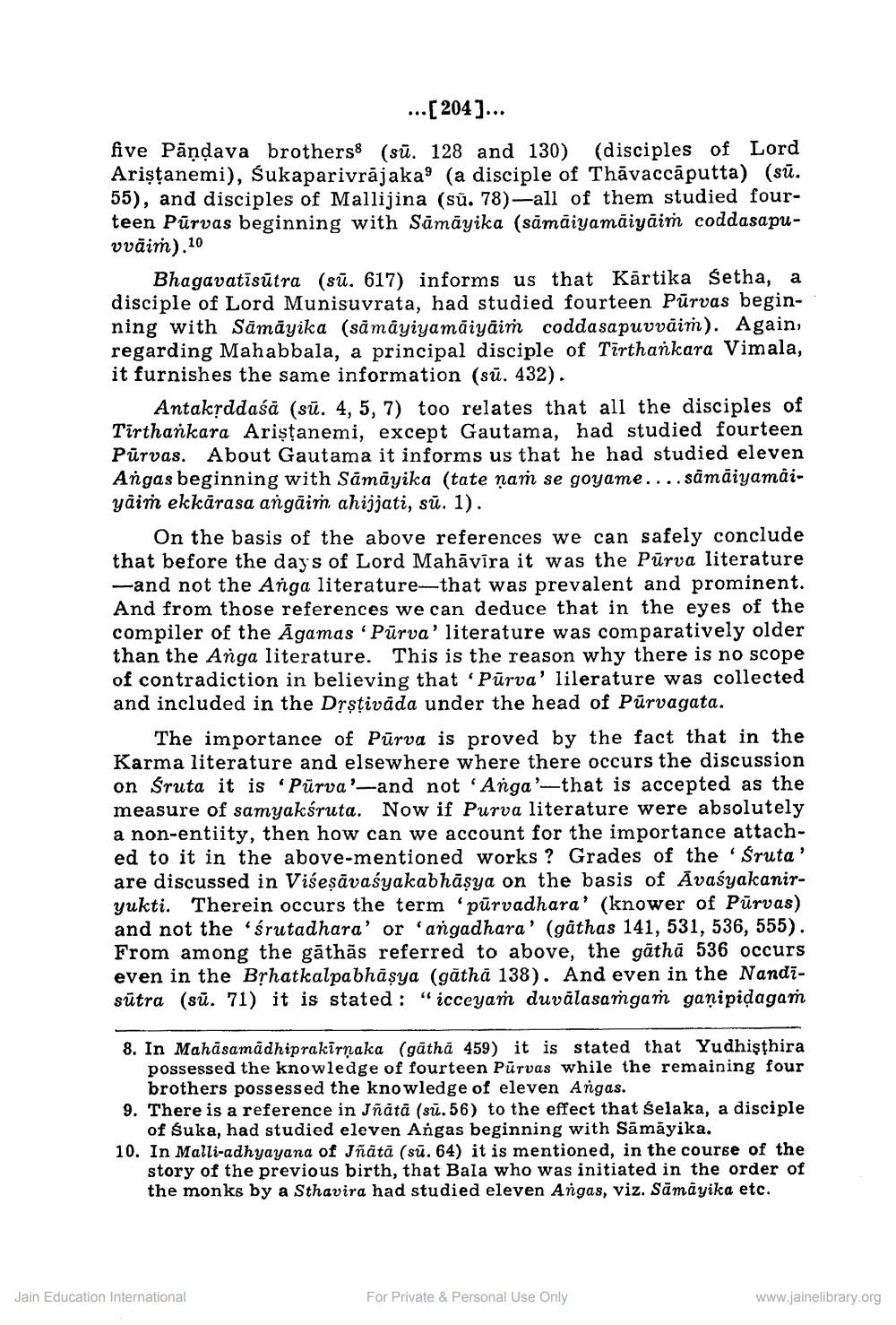________________
... [204]... five Pändava brothers8 (sū. 128 and 130) (disciples of Lord Aristanemi), Sukaparivrājaka (a disciple of Thāvaccāputta) (sū. 55), and disciples of Mallijina (sū. 78)—all of them studied fourteen pūrvas beginning with Sāmāyika (sămâiyamaiyaim coddasapuvväiṁ).10
Bhagavatīsūtra (sū. 617) informs us that Kārtika Setha, a disciple of Lord Munisuvrata, had studied fourteen Pūrvas beginning with Sāmāyika (sāmāyiyamãiyāim coddasapuvväim). Again, regarding Mahabbala, a principal disciple of Tirthankara Vimala, it furnishes the same information (sū. 432).
Antakyddaśā (sū. 4, 5, 7) too relates that all the disciples of Tirthankara Aristanemi, except Gautama, had studied fourteen Pūrvas. About Gautama it informs us that he had studied eleven Angas beginning with Sāmāyika (tate nam se goyame....sāmäiyamaiyaiṁ ekkārasa angāim ahijjati, sū. 1).
On the basis of the above references we can safely conclude that before the days of Lord Mahāvira it was the Pūrva literature -and not the Anga literature-that was prevalent and prominent. And from those references we can deduce that in the eyes of the compiler of the Āgamas "Purva' literature was comparatively older than the Anga literature. This is the reason why there is no scope of contradiction in believing that "Purva' lilerature was collected and included in the Drștivāda under the head of Pūrvagata.
The importance of Pūrva is proved by the fact that in the Karma literature and elsewhere where there occurs the discussion on Sruta it is 'Purva'-and not 'Anga'-that is accepted as the measure of samyakśruta. Now if Purva literature were absolutely a non-entiity, then how can we account for the importance attached to it in the above-mentioned works ? Grades of the Sruta' are discussed in Višeşāvaśyakabhāsya on the basis of Avaśyakaniryukti. Therein occurs the term pūrvadhara' (knower of Pūrvas) and not the 'śrutadhara' or 'angadhara' (gåthas 141, 531, 536, 555). From among the gāthās referred to above, the gāthă 536 occurs even in the Brhatkalpabhāsya (găth, 138). And even in the Nandisūtra (sū. 71) it is stated : “icceyam duvālasamgaṁ ganipidagań
8. In Mahasamadhiprakirnaka (gātha 459) it is stated that Yudhisthira
possessed the knowledge of fourteen Purvas while the remaining four
brothers possessed the knowledge of eleven Angas. 9. There is a reference in Jñātā (sū.56) to the effect that selaka, a disciple
of śuka, had studied eleven Angas beginning with Sāmāyika. 10. In Malli-adhyayana of Iñātā (sū. 64) it is mentioned, in the course of the
story of the previous birth, that Bala who was initiated in the order of the monks by a Sthavira had studied eleven Angas, viz. Sāmāyika etc.
Jain Education International
For Private & Personal Use Only
www.jainelibrary.org




